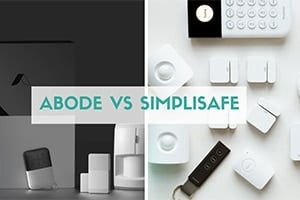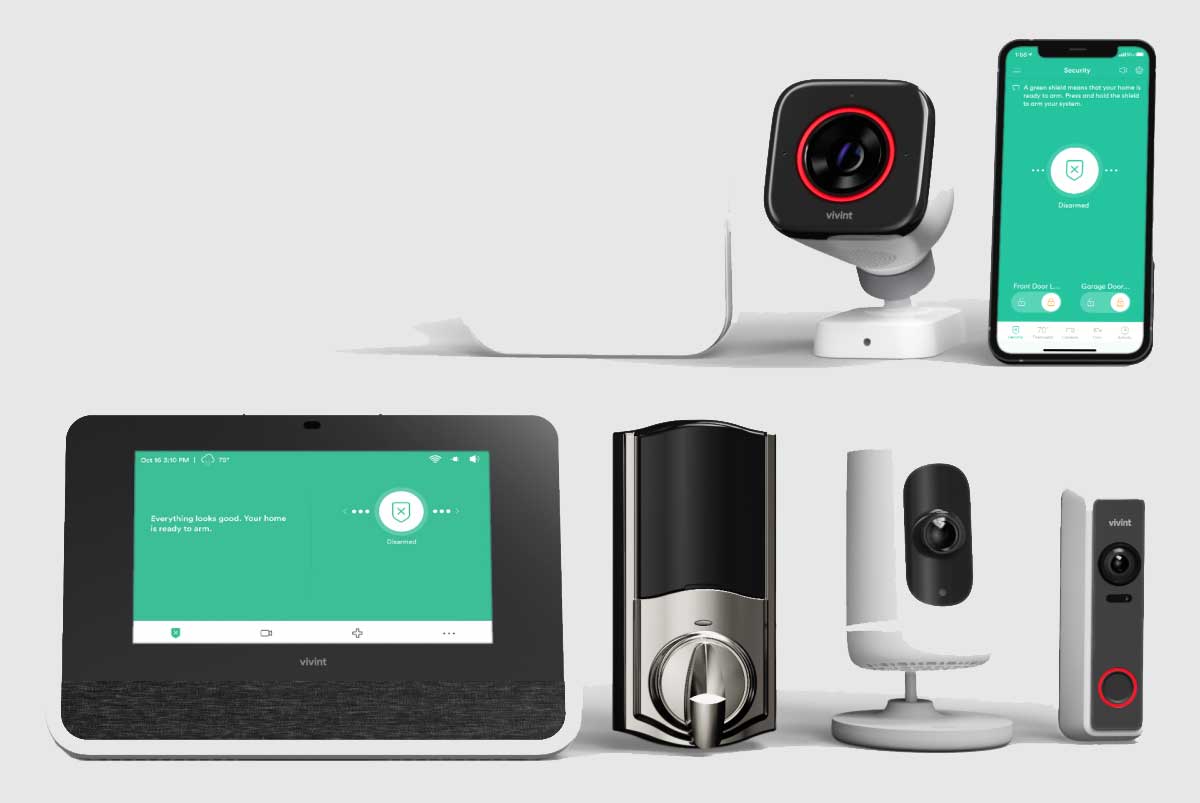How To Install A Home Security System: Cameras, Carbon Monoxide, Fire/Smoke, Flood/Freeze, Motion, Glass Break, & More
When you purchase through links on our site, we may earn a commission. Here’s how it works.

Most security systems that are installed by the homeowner are wireless, so for this article, we’ll be discussing how to install a wireless security system. If the alarm system you are buying is a wired system, the company will most likely send a professional to your home to set up the system.
Security System Installation
Here’s a listing of the types of security sensors we discuss in this article, which includes not only optimal placement but typical installation steps so you’ll get an idea of what you’re in for. We selected what we consider to be the most popular and widely available sensors.
- Cameras
- Control Panels
- Carbon Monoxide Detectors
- Door/Window Sensors
- Fire/Smoke Detectors
- Flood Sensors
- Freeze Sensors
- Glass Break Sensors
- Motion Sensors
Peel And Stick Sensors
A quick note on how most of these sensors are typically attached to walls before we begin – peel-and-stick. It’s a good idea to make sure the surface is clean and dry before sticking a device to it. This will help ensure a secure hold. For those wondering how strong peel-and-stick is and how long it lasts, our motion sensors were put up 10 years ago and are still going strong.
We use these command strips by 3M, an inexpensive alternative if you feel the strips shipping with your sensor aren’t adequate.
Test Mode
Also, most sensors have testing modes you can use to verify that their installation and location is effective before you deploy them live to your security system. See the manufacturer’s specific instructions for how to initiate test modes.
Please note that these are general tips. Read your security system/device instructions for more specific instructions.
What’s The Best Place To Install Security Cameras?
Before we get into the specifics of outdoor and indoor cameras, below are some general guidelines to keep in mind.
- If possible, place the camera at least 9 feet off the ground, so intruders cannot easily tamper with the camera.
- For outdoor cameras, try to install them under a porch or roof hanging to help protect it from the weather.
- Larger field of view cameras (above 120°) are best for wide areas, like overlooking your backyard or above your garage door.
- Small field of view cameras (less than 75°) are best aimed directly at a door or parked car in the driveway.
Read our guide on home security cameras installation for more.
Outdoor Security Cameras
If you plan on installing some outdoor security cameras, consider placing them in these locations:
- Near the front door
- Near the back door
- Pointing toward the garage/driveway
- Aiming toward any sheds or buildings on your property
- Around first level windows with low lighting
Keep in mind that the most important thing to capture from your security camera is a clear image of a face or license plate.
We recommend the ZOSI weatherproof home surveillance system.
Reviews Of Outdoor Security Cameras
How To Install Outdoor Cameras?
The most common way to install an outdoor security camera is by purchasing a mount (some cameras include mounts) and screwing it into a fixture (like a tree, the side of your house, porch railing, etc.). This process is pretty simple, especially if you have an electric drill.
Indoor Security Cameras
Indoor security cameras are less popular than outdoor cameras because people don’t want to feel like someone is watching them inside their home. However, if you do plan on installing some indoor security cameras, these are some good places:
- Near basement stairs
- Facing entry points to the basement (windows or doors)
- Aiming toward the front door and back door
We recommend the Google Nest Indoor Camera.
Another great use for an indoor camera is to have it triggered by a motion sensor. That way, if there’s a break-in, you may capture the perpetrator on video.
Reviews Of Indoor Security Cameras
How To Install Indoor Cameras?
There are typically two ways to install an indoor security camera:
- Place it on a shelf, counter, desk, etc. and point it toward the area you want monitoring.
- Screw a camera mount into your wall and connect the camera to it.
I have experience with both installation forms, and both options are straightforward.
Where Should A Control Panel Go?
Some systems require specific control panel placement. If the decision is left up to you, here are some recommendations we have.
It’s always a good idea to install the control panel in a concealed place, aka don’t put it right next to the front door in the entryway. You’ll want to install it in a room that isn’t next to any entry or exit points. Some places to consider are the master bedroom or home office. A garage or basement can be a good option as well depending on how accessible these locations are.
You can either screw a control panel into the wall or sit on a tabletop or shelf. Some require a plug to be nearby while others are battery operated.
Reviews Of Home Security Systems
How Many Carbon Monoxide Detectors Do I Need?
We recommend having at least one carbon monoxide (CO) detector on each level of your home. These should be placed approximately 5 feet from the floor. Some common locations for CO alarms include in hallways near bedrooms, living rooms and near doors that lead to the garage.
You should not put CO detectors inside garages, bathrooms, furnace rooms, crawl spaces or unfinished attacks. You should also avoid placing them near appliances. Why? Particles from these areas may trigger false alarms.
What Are The Different Types Of Carbon Monoxide Alarms?
Below are four common ways you may see CO detectors installed.
- Interconnected with a fire/smoke alarm, installed on the ceiling
- Plugged into an outlet
- Resting on a tabletop
- Mounted on a wall
We recommend the Kidde Digital Display Carbon Monoxide Alarm.
Reviews Of Carbon Monoxide Detectors
Do I Need A Sensor On Every Door And Window?
If you have the budget for it, we suggest placing a door/window sensor (these are also called contact sensors since they initiate an alarm state when their surface loses contact) on every door and window on the main level of your house and basement. Alternatively, you can install a motion sensor or glass break sensor to cover several windows at once. It’s always a good idea to “double down” on different types of sensors in case a burglar finds a way to get around one of your lines of defenses. For example, if they break through a window vs. opening it, the window sensor will not be tripped. If you have a backup glass break sensor (or motion sensor covering that window) installed, they will be tripped when the perpetrator enters through the broken window.
Eventually, we’d like for you to expand your system to the second level of your home (if you have one). Although most intruders access a home through the main level, it’s essential to cover all your bases. You’re already being diligent and covering other areas of your home, so don’t slack on this one. As a basic safety tip, don’t leave ladders lying around, and trim any trees that may give easy access to the second level of your home.
Door and window sensors are super simple to install since they typically peel and stick. The main difference is that companies may require that they be only a certain distance apart from each part of the sensor, so make sure you read the instructions carefully and have each component of the sensor within the allotted space. If you position the two elements too far away from one another, they will be in a constant triggered state.
Also, we suggest placing these towards the tops of doors and windows. That way they are less likely to get bumped off. How many times do you enter the house with your arms full of groceries? Do you have young kids who like to play with things? These are just two reasons you’ll want that door sensor higher up.
Where Should I Install Fire/Smoke Detectors?
Fire and smoke detectors typically come as a combined (single) unit. This is the one detector in this article that is commonly wired, so we’ll discuss the wired option here. We suggest you look for an alarm that detects fire, heat and smoke all in one unit.
It is recommended to have at least one fire/smoke alarm on each level of your home as well as every bedroom. In fact, for many homes this is now required as part of the building code. You’ll also want to consider placing them near attics, on landing areas between levels and in living rooms.
The best place to install fire/smoke alarms is near doorways toward the main areas. For example, in bedrooms, you should have them placed near the door to the hallway.
Note that wired alarms can be a little more tricky to install, so you may want to call a professional to help. Wireless alarms are much more straightforward to install and require only a couple of screws into the ceiling or wall (and some are offered via peel-and-stick even).
We recommend the First Alert BRK Photoelectric and Ionization Smoke Alarm.
Are Flood Sensors Necessary?
Speaking from someone who rang in 2018 with a pipe burst in her basement, yes, flood sensors are a must! At the time of our pipe burst, we didn’t have flood sensors, but fortunately, we were home to prevent extreme damage to our basement.
Had we not been home at the time, we could have arrived home to a flooded basement with all of our new furniture and electronics ruined. Not to mention the loss of our two dogs, since that’s where we keep them when we’re away. Fortunately, this wasn’t the case.
Flood sensors should be installed in the basement (or first level of your home if you don’t have a basement). You can get a notification before water reaches your basement by placing a flood sensor inside the sump pump.
Other common places include the kitchen, laundry room and near the water heater. Appliances like sinks, dishwashers and washing machines pose the risk of malfunctioning and dispersing water throughout your home.
Install your sensor on the lowest part of your wall or even onto the floor. The lower down the sensor is the sooner it will detect water. Most of these sensors are peel and stick, so they’re super simple to install.
We recommend the Flume Smart Water Monitor.
What’s The Best Place For Freeze Sensors?
There are indoor and outdoor freeze sensors, so before purchasing make sure you are getting the type you want.
Common places to install a freeze sensor include rooms where you have antiques, art or other objects that need to be at specific temperatures. Other common areas are attics and basements because these areas have many pipes and are prone to being colder than the rest of the house and pose a threat of freezing.
In a vacation home, consider installing a freeze sensor near the thermostat. This will notify you that the thermostat is broken and alert you that you need to get it fixed before your pipes freeze. See more vacation home security tips.
For outdoor areas, placing a freeze sensor by the pool, fountain, faucet or sprinkler system is also a good idea. Looking back, I wish I had done this to my outdoor faucet. It could’ve saved me thousands of dollars in repairs.
The installation of these can vary drastically, so we recommend reading the instructions carefully. Most of them are peel and stick, but the exact placement may vary. Some allow for them to be placed directly on pipes, while others need to be placed on a wall nearby.
We recommend the Honeywell Freeze Detector.
Where Should Glass Break Sensors Go?
If someone breaks a window to obtain access to your home the window sensor won’t be triggered unless the intruder unlocks the window and opens it, so you’ll want to receive a notification if the glass breaks too.
On average, a glass break sensor can cover about a 20-foot range. This makes them perfect for living rooms and other large, open areas in your home. You can place these in any room with a window or glass door, but it’s nice when you can cover multiple doors and windows with one sensor.
Walls and ceilings are common places to put these sensors, which are typically peel-and-stick. Again, make sure you read the instructions carefully so you know how far the device can be from the doors/windows.
Make sure there are no walls or large pieces of furniture between the sensor and the doors/windows because it can interfere with the accuracy of the glass break sensor. Glass break sensors, like most sensors, have a test mode you can use to see if the sensor’s location is effective. Typically you’ll clap your hands and the sensor will illuminate if it registers your clap. You can stand by windows and see if your clap triggers the sensor.
We recommend the Honeywell Wireless Glass Break Detector.
Tip To Save Money And Purchase Fewer Sensors
As mentioned earlier in the article, there are ways to combine sensors not only for added security, but cost savings as well. Let’s say you have four windows and a glass patio door in your living room. Instead of purchasing five door/window sensors you could buy one glass break sensor and one motion sensor to cover the entire room and potentially save some money.
The glass break sensor will notify you if someone breaks the glass and the motion sensor will inform you if someone enters through the door or window and begins rummaging through your home.
How Many Motion Sensors Do I Need?
You can put motion sensors anywhere, but they are great for covering large or highly trafficked areas. To get the most out of our motion sensor, you’ll want to install it in an area where there are many access points.
Common areas include living rooms, entryways, large gathering areas and other large spaces in open concept homes. You can also install motion sensors in other places of your home that you don’t want people entering. Again, these sensors are generally peel and stick and very easy to install.
Read the instructions for the device because the angle and height you place the sensor can impact its effectiveness. Generally, companies recommend putting them at eye level and in corners, so they can cover more area. Pets can also trigger motion sensors. Typically smaller pets such as cats will not trigger them, but larger dogs may. Check your sensor manual for which height/weight parameters you need to be on the lookout for.
If your home security system has a home or away mode – you’ll want to take this into account. Typically “home” mode means you’re at home, and only door and window sensors are armed. In “away” mode, the alarm system assumes you’re gone, so motion sensors are armed as well. You’ll want to take this into account in the event that you want motion sensors armed, while you’re say, sleeping. In that case having them in your bedroom won’t let you use “away” mode at night, unless your system allows for targeting of individual sensors.
Home Security Doesn’t Have To Be Hard
We hope you found some simple ways to improve your home’s security in our article. We think home security is a must, but that doesn’t mean it has to make you pull your hair out.
If you want some other ideas for how you can deter burglars and secure your property further, read our article, how to scare burglars away. Some of the tips don’t require you to spend a penny.




